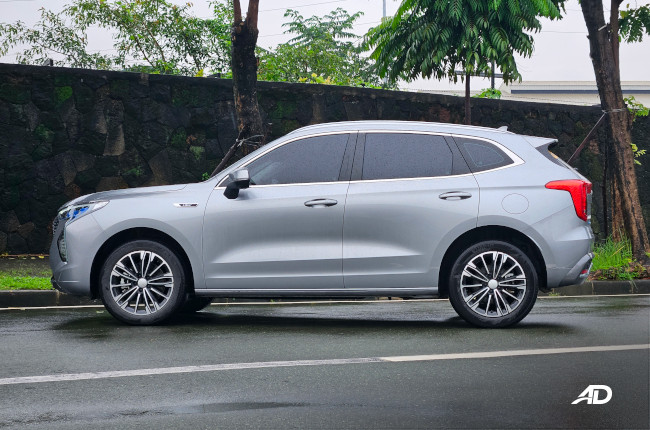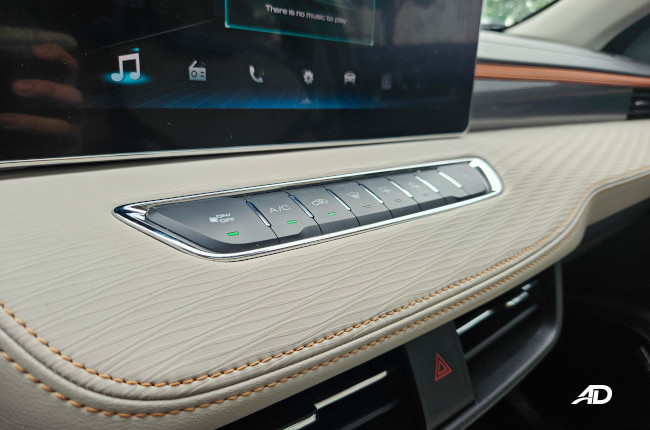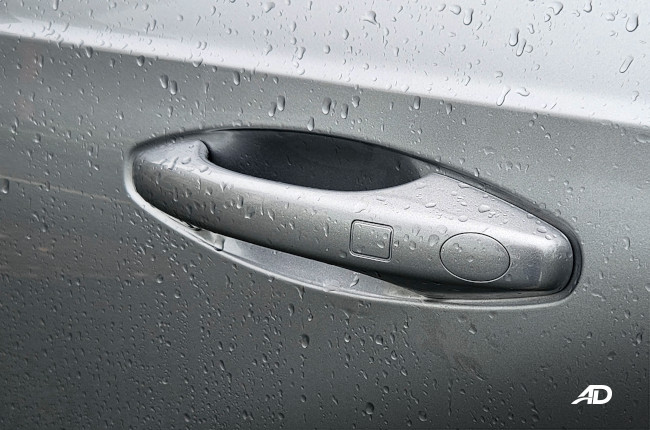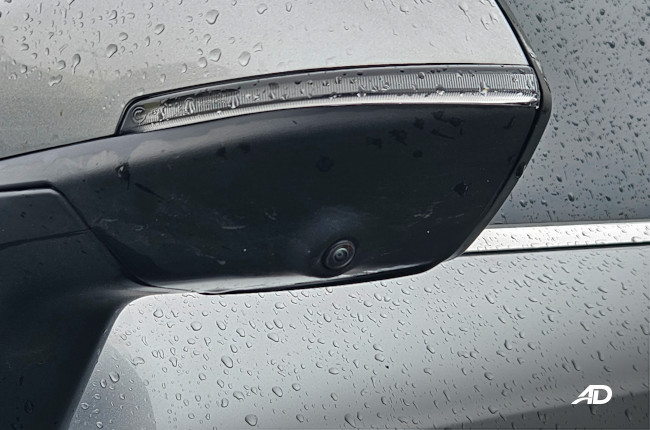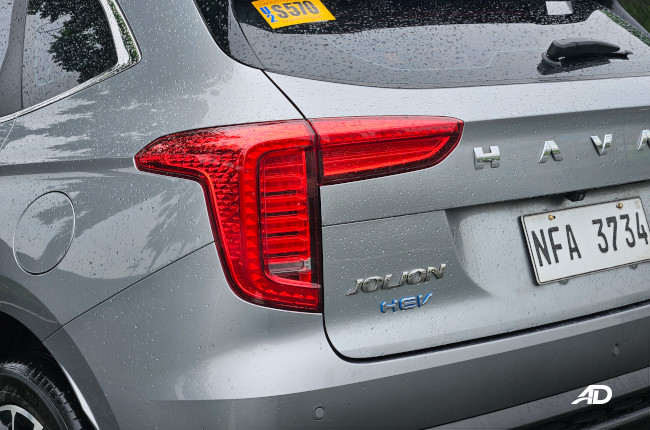
When GWM relaunched in the Philippines, it brought with it a bunch of crossovers, but these were no ordinary run-of-the-mill vehicles, there were a bunch of HEVs and this is one of them, the GWM Haval Jolion HEV DHT Supreme.
We wondered whether GWM was brave or foolish to bump heads with more established brands in the HEV segment. Heck, even considering the gasoline-only crossovers out in the market, the Jolion may have its work cut out for it going up against the likes of Toyota, Nissan, and other brands with non-hybrid crossovers. We will say, however, that the Jolion HEV does have a lot of things going for it.
Engine Output (HP), Acceleration, Transmission, Handling 4.5/5
Exterior & Interior Design, Quality, Fit and Finish, Ergonomics 3.5/5
Cabin Comfort, Suspension, NVH Insulation 4.5/5
Convenience Technologies, Active and Passive Safety Features 4.0/5
Amount of the vehicle you get for the price, Fuel Efficiency 3.5/5
- Extremely smooth electric and gasoline motor transitions
- One Pedal system is very convenient for driving in traffic
- Very competent to drive
- Screens and cameras are bright and clear
- Light-colored interior could age poorly and not to everyone's tastes
- Infotainment and gauge cluster software is hard to navigate
- Cargo door opening is narrow
- Could use more buttons to streamline software experience
Exterior
From the outside, the Jolion may turn a few heads or raise a few eyebrows depending on what you believe is a good-looking car. We will say that it looks presentable and rather futuristic with the striking DRLs and turn indicators, LED headlamps, and an LED rear light setup with a rear fog. However, there are a few touches in the front like the Haval badge, that don’t really mesh well with the car. The mesh grille, on the other hand, is a nice touch, and as a whole, it looks decent.
The rear of the car is neither striking nor boring. There’s just enough visual interest at the back to make an impression, but looking closer and you will see a ton of badges which include the Haval Logo, the Hybrid logo, the GWM logo, and also the Jolion logo all spelled out. The wheels look good with a dual-tone finish and it sits on approximately 168 mm of ground clearance, but the rest of the side isn’t too visually interesting. Simple is the word, but it’s nice and safe.
We mentioned in our video review to “not judge a book by its cover,” and as such we spent more time driving this car than looking at it. Overall, however, it’s a decent-looking vehicle. Perhaps it’s just outshone by other cars like the GAC Emzoom, or the Mazda CX-30, or perhaps it’s caught in the hype for hybrid Toyotas. Whether or not those cars are contributing to our opinions about the Jolion is up for debate, but overall it’s a respectable effort from a brand that has yet to establish its identity once again in the Philippine market.
Interior
Stepping inside, you’ll be greeted with beige leather, not a lot of glossy plastics, and black and copper/bronze accents. With the color palate that GWM has going on, however, the initial impression is that it’ll be a premium and welcoming experience in the cabin. However, there are a some parts of the interior that we’re not too fond of. We understand that GWM is rather proud of the Haval brand, but to have four seats out of five with the logo embroidered is a little too on the nose, perhaps a little tacky if you want to be brutal about it. We think it’s a good effort, just a little too much given that the interior is already as flashy as it is. We do understand the peg that GWM was going for here, and we do appreciate the effort to set itself apart and clean everything up, but there are a few cons that we found during our drive.
The main pain point that we had with the interior was access to the AC controls and the other most-adjusted features on the car. There aren’t enough buttons in the car that correspond to the number of features it has. While everything is accessible through the infotainment screen and should be accessed before you set off anyway. However, we do wish that the steering wheel had more dedicated buttons to access the rest of the info display’s data much easier.
As for the numbers, you get 430 liters of space at the back but the opening is a little narrow and the cargo area is a bit shallow. You can fold the 60-40 rear seats down for more space, but the Jolion definitely isn’t the best in terms of its cargo-hauling chops. It’s still rather serviceable, but a little bit compromised in the cargo area, but we’re happy to report that the rear seats are very spacious and able to accommodate larger individuals with no problem.
Overall, there are a few elements that we don’t particularly love but are accepting of in this car. The interior is a little on the lighter side of things and might show signs of age quicker than other cars, the rear seat space is generous, but the opening to the cargo hold is a little tight. Accessing the technology features in this car will take a little longer than normal because of the lack of buttons, but that’s also because there are a ton of features here that are worth shouting about to some degree.
Comfort

The seats of the Jolion don’t have a lot of curves and are pretty flat. While there are people that will prefer this, the lack of support in the back area of all seats may take its toll on you for longer drives or rides as a passenger. Otherwise, the interior is padded nicely with all the touchpoints covered and soft. Apart from that, getting into your driving position is easy with power seats, but tough to really dial in the reach because the steering wheel doesn’t telescope.
However, handling on bumpy roads is great, and came as a surprise to all of us. The chassis was planted over bumps, and the model featured a lot of give when it came to the deeper gashes in the asphalt. In whatever case, NVH was also a high point, as little to no wind noise seemed to penetrate the cabin, and paired with the refined sound of the hybrid system, we can actually say that the car is more comfortable than most.
Technology
For tech, we found ourselves rather impressed with the kit that GWM was able to provide. Not everything was perfect and we do wish that there was more cohesion in the lineup with regard to interface and software, but the overall package is pretty good but in need of a little more refinement.
The infotainment screen is a 12.35-inch display that is one of the clearer ones out there. Color reproduction from this screen was great and as was the resolution. The screen was able to display our Apple CarPlay and Android Auto functions rather well since it is also a widescreen and allows for full-sized multi-displays for either software. Moving over to the gauge cluster, you have a TFT display that shows you everything you need to know at a glance, and it’s paired with a heads-up display that can be edited in the settings. All the displays are clear, and both will be home to your advanced driver assist system (ADAS) info. However, getting to those displays is a little cumbersome as the buttons on your steering wheel aren’t too explicit about which one to press to get to your other bits of information. After a few presses here and there, we were able to get tire pressure monitoring, adaptive cruise, trip information, and hybrid power distribution among other things, but the system likes to default back to the ADAS display which was a bit annoying.
Going back to the infotainment system a bit, you do need to interact with the touchscreen and the settings inside the menus in order to activate or deactivate the features that you want. For example, the Jolion HEV features a one-pedal feature that will allow the car to use its charging system as the brakes. In essence, this feature works like an engine brake, but the on or off button was buried deep in the infotainment system’s menus. Other than that, lane-keeping, forward collision warning and other ADAS functions took a while to get to, but you have a lot like driver fatigue monitoring, automatic emergency braking, blind spot warning, cross traffic alert, forward collision warning, intelligent cornering control, lane center keeping assist, lane change assist, lane departure warning, lane keeping assist, rear collision warning, traffic jam assist, emergency lane keeping assist, and others.

On the note of accessibility, it’s interesting to note that the easiest special feature to access in this car is the 360-degree view camera with a button on the dashboard. The cameras are very clear even at night and it even comes with extra views to allow you to get the full picture of your car from an outside perspective. This was the icing on top of the cake, and most of the tech features here are pretty sorted. The lane-keeping assist systems are a little on the aggressive side, however, but whatever feature you turn on or off in the infotainment system, they stay off or stay on every time you start the car after you set it. Oh, plus we found that the car comes with heated seats while poking around in the infotainment system.
Safety

As for safety, the Jolion scored high in ANCAP tests, with five stars on the board. The ASEAN NCAP has yet to publish its results and it’s not known if the testing body received or queued the car for testing at the time of writing. Other than that, ABS is standard, with six airbags, ISOFIX tethers, brake assist, electronic stability control, hill-start assist, roll-movement intervention, secondary collision mitigation, traction control, tire pressure monitoring, automatic crash unlock function, automatic locking return function, automatic fuel cut-off function, and intelligent door anti error locking function.
The Jolion features a complete package of safety, something that we appreciate a lot especially paired with the ADAS system which includes adaptive cruise control, automatic emergency braking, blind spot warning, cross traffic alert and brake, forward collision warning, intelligent cornering control, lane center keeping assist, lane change assist, lane departure warning, lane keeping assist, rear collision warning, traffic jam assist, and emergency lane keeping assist.
Driving and Handling
While the exterior and interior might not have thoroughly impressed us, it’s the drive that was most shocking. Equipped with a 1.5-liter Series Parallel Combined hybrid-electric system, the model produces 186 hp and 375 Nm of torque. GWM is also proud of its electric motor since the gasoline engine alone only accounts for 94 hp and 125 Nm of torque. The load distribution between the gasoline and electric motor is more or less 50-50, which means that you can expect the best of both worlds in a manner of speaking.

The powertrain is mated to a dedicated hybrid transmission, or DHT as GWM likes to call it. It’s not like the adapted transmission setups that we see in more gasoline motors nowadays, and the fact that it is dedicated to the hybrid system means that you can expect extremely smooth acceleration whether it's stop-and-go traffic or getting up to speed on the highway.

Cornering and handling behavior is another strong point in this car. A crossover it is, so a unibody chassis we expect, paired with the well-tuned dampers, and we have ourselves a recipe for a planted yet comfy ride. The dampers here aren’t stiff so handling won’t be anything sporty, but over the bumps and potholes of EDSA and C5, it’s quite refined. That and the engine smoothly accelerates without letting out a whine and a large pur, and we have something a bit special.

Even switching over from the electric motor to the gasoline engine is smooth. The performance when one is active is smooth, but things can get pretty interesting when both are working to deliver all the power it promises on the spec sheet. Overall, the drive of this car was not what we expected, it actually exceeded our initial expectations in terms of refinement and performance.
Fuel consumption

In very bad traffic, we were able to get 12.8 km/L in the Jolion, when that opens up, you can actually get closer to the highway figure of 18 km/L. Whether you’re on the highway or in the city, you can expect around this fuel economy figure. Not quite as impressive as we hoped, but we will say that for the majority of your driving in the city, it’s a rather frugal automobile.
Verdict and Price

For P1,588,000 for this GWM Haval Jolion HEV. If you ask us, where your money will go when you buy this car is not necessarily all going into a flashy design and some features you’ll never use. We see that worth being put into the drive and ride of the car. Don’t get me wrong, you still get all of the advanced features currently sought-after by tech-savvy buyers, but in a package that is just about as pleasing to drive as maybe the Corolla Cross or the newly-launched Yaris Cross, if not a little better in some areas.
For the price of this car, it may still be a bit of an ask for some buyers, especially since GWM is a new player in the hybrid crossover scene. Regardless of that, however, the Jolion is perhaps one of the more surprising cars out there.
So to answer the question of whether GWM is brave or foolish, we think brave. The Jolion will have to face an uphill battle against its other rivals, however, butting heads with other established brands. However, car-against-car, we think that the Jolion can hold its own up against the class leaders.
Exterior Photo Gallery
Interior Photo Gallery
Specifications
Engine
1.5 LFuel Type
HybridPerformance
94 hp @ 5,600 rpmTransmission
Automatic-
Summary
-
Name GWM Haval Jolion HEV DHT Supreme Body Type Crossover Price ₱1,588,000 Transmission Category Automatic -
Engine
-
Engine Size 1.5 L Displacement 1,498 cc Number of Cylinders 4 Number of Valves 16 Transmission Type Dedicated Hybrid Transmission -
Performance
-
Drivetrain Front-Wheel Drive Max Output (hp) 94 hp @ 5,600 rpm Max Torque (nm) 125 Nm @ 2,000 rpm -
Economy & Environment
-
Fuel Type Hybrid Emissions Standard Euro 5 Fuel Capacity 55.0 L *Combined Fuel Consumption 15 km/L *brand manufacturer claim
-
Dimensions
-
Length 4,472 mm Width 1,841 mm Height 1,574 mm Wheelbase 2,700 mm Turning Circle 12 m Ground Clearance 168 mm Trunk Capacity 390 L Number of Doors 5 Number of Seats 5 -
Safety & Security
-
Driver's Airbag 1 Front Passenger's Airbag 1 Side Airbag 2 Curtain Airbag Knee Airbag Auto Brake System Electronic Brake Distribution Anti-lock Brake System (ABS) w/ Electronic Brakeforce Distribution
Immobilizer Security Alarm Stability Control Electronic Door Locks Speed Sensing Door Locks ISOFIX Lane Departure Warning System Blind-Spot Detection System -
Features
-
Cruise Control Front Parking Sensors Rear Parking Sensors Leather Upholstery Push Start Button Wheel Size 18 in Wheels Metal Type Alloy Airconditioning System Dual Zone Automatic + Rear A/C Vents Entertainment System 12.3-inch Touch Screen via 6-Speakers Connectivity Apple Carplay + Android Auto + Bluetooth + USB Navigation Ready Warranty 7 Years(200,000KM) Keyless Entry Roof Rack Sunroof Electric Adjustable Seats Power Steering Power Windows Power Outlet Steering Wheel Audio Control -
Technology
-
Active Park Assist Hill Start Assist AWD Modes n/a Tire Pressure Monitoring Heads-up Display Power Liftgate Start-stop System
Colors
Latest Review
-
Addictively excessive: The Ford Ranger Raptor Twin Turbo V6 / Review
The Ford Ranger Raptor Twin Turbo V6 is one crazy pickup truck. Wondering why? Just keep reading.
4.6 / 5 -
The Kia Carnival gives you more: More seats, more comfort, and more practicality / Review
The Kia Carnival is a three-row MPV designed for executives and families. It combines comfort, technology, and practicality, making it a strong choice for those looking for a premium people...
4.2 / 5 -
The Jetour Ice Cream: A pint-sized EV that’s hard to ignore / Review
The Jetour Ice Cream is an adorable, pint-sized electric car that’s made for the city. Affordable and stylish, it’s easy to love, but does it tick all the boxes for you?
3.7 / 5
Popular Articles
-
Cheapest cars under P700,000 in the Philippines
Jerome Tresvalles · Sep 02, 2024
-
First car or next car, the Ford EcoSport is a tough package to beat
Jun 18, 2021
-
Car Maintenance checklist and guide – here’s everything you need to know
Earl Lee · Jan 12, 2021
-
Most fuel efficient family cars in the Philippines
Bryan Aaron Rivera · Nov 27, 2020
-
2021 Geely Okavango — Everything you need to know
Joey Deriquito · Nov 19, 2020
-
Family cars in the Philippines with the biggest trunks
Sep 20, 2023
-
Head to head: Toyota Rush vs. Suzuki XL7
Joey Deriquito · Oct 28, 2020
-
Why oil changes are important for your car
Earl Lee · Nov 10, 2020
-
2021 Kia Stonic — What you need to know about it
Joey Deriquito · Oct 16, 2020
-
Top 7 tips for buying a used car in the Philippines
Joey Deriquito · Nov 26, 2020



